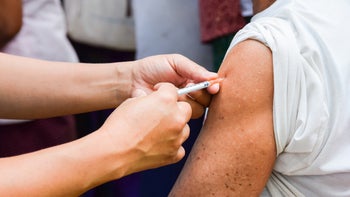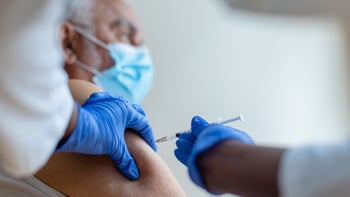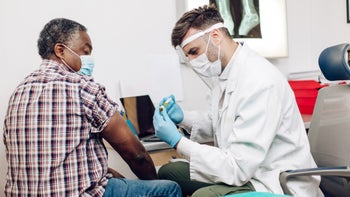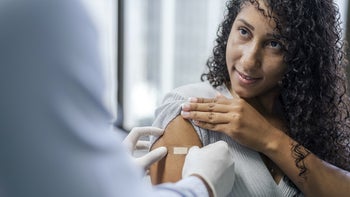
Is Shingrix a Live Vaccine? Plus, 7 Other Shingles Vaccine FAQs Answered
Key takeaways:
Shingrix is currently the only shingles vaccine available in the U.S. It’s recommended as a two-dose series for adults ages 50 and older. Adults ages 19 and older with a weakened immune system are also eligible for Shingrix.
Shingrix is not a live vaccine. Instead, it contains pieces of the virus that causes shingles. Zostavax was a live shingles vaccine that’s no longer available in the U.S.
Shingrix is more than 90% effective at preventing shingles and its complications in adults with healthy immune systems. Protection from the vaccine has been shown to last for at least 10 years.
Common Shingrix side effects include temporary pain at the injection site, headache, and shivering. Some side effects might be worse after your second dose.
Access savings on related medications
Table of contents

It’s estimated that around 1 out of 3 people in the U.S. will develop shingles in their lifetime. In addition to causing a painful rash, the effects of shingles can linger much longer for some people and cause serious problems. Fortunately, there’s an effective tool that can help prevent shingles and its complications: Shingrix.
Shingrix is currently the only shingles vaccine available in the U.S. It replaced a live vaccine called Zostavax, which was discontinued in 2020.
If you’re eligible for Shingrix, you may have some questions about how it works, side effects, and more. We answer eight common Shingrix questions below.
SHINGRIX (Zoster Vaccine Recombinant, Adjuvanted) is now $0 for almost everyone*
Get SHINGRIX at the pharmacy or in-network doctor’s office today. 98% of privately insured people pay $0 and all Medicare Part D beneficiaries pay $0 at the pharmacy.
Prescribing Information
*Coverage and cost may vary and are subject to change without notice. Reimbursement decisions are made by individual insurance plans.


SHINGRIX is an FDA-approved vaccine for the prevention of shingles (herpes zoster) in adults 50 years and older. SHINGRIX is not used to prevent chickenpox.
• You should not receive SHINGRIX if you are allergic to any of its ingredients or had an allergic reaction to a previous dose of SHINGRIX
• An increased risk of Guillain-Barré syndrome (severe muscle weakness) was observed after vaccination with SHINGRIX
• Fainting can happen after getting injectable vaccines, including SHINGRIX. Precautions should be taken to avoid falling and injury due to fainting
• The most common side effects are pain, redness, and swelling at the injection site, muscle pain, tiredness, headache, shivering, fever, and upset stomach
• SHINGRIX was not studied in pregnant or nursing women. Tell your healthcare provider if you are pregnant, plan to become pregnant, or are breastfeeding
• Vaccination with SHINGRIX may not protect all individuals
• Ask your healthcare provider about the risks and benefits of SHINGRIX. Only a healthcare provider can decide if SHINGRIX is right for you
You are encouraged to report vaccine adverse events to the US Department of Health and Human Services. Visit www.vaers.hhs.gov to file a report, or call 1-800-822-7967.
For US audiences.
Trademarks are property of their respective owners.
©️2024 GSK or licensor.
PMUS-SGXWCNT240015 May 2024
Produced in the USA.
GoodRx Health information and resources are reviewed by our editorial staff with medical and healthcare policy and pricing experience. See our editorial policy for more detail. We also provide access to services offered by GoodRx and our partners when we think these services might be useful to our visitors. We may receive compensation when a user decides to leverage these services, but making them available does not influence the medical content our editorial staff provides.
1. What is the shingles vaccine (Shingrix)?
Shingrix is a vaccine that helps prevent herpes zoster, or shingles. It’s recommended as a two-dose series for adults ages 50 and older. People ages 19 and older with weakened immune systems are also eligible to receive Shingrix. Like most other vaccines, it’s given as an injection into the muscle of the upper arm.
Shingles is caused by the varicella-zoster virus, which is the same virus that causes chickenpox. If you get chickenpox, the virus stays in your body and can become active again later in life. When this happens, you can develop shingles, which shows up as a painful rash. For some people, shingles can result in long-term nerve pain called postherpetic neuralgia (PHN).
By getting Shingrix, you train your body to protect itself from the varicella-zoster virus. In adults with healthy immune systems, the vaccine is over 90% effective at preventing shingles and its complications, including PHN. And you can still benefit from Shingrix, even if you’ve had shingles in the past.
2. Is Shingrix a live vaccine?
No, Shingrix isn’t a live vaccine. It’s a recombinant adjuvant subunit vaccine. This means it contains pieces of the varicella-zoster virus instead of the virus itself. It also contains an adjuvant, which is a substance that helps your immune system respond to the vaccine better.
Shingrix is sometimes confused with an older, live shingles vaccine called Zostavax. Zostavax wasn’t as effective as Shingrix, resulting in experts recommending Shingrix over Zostavax in 2018. As of November 2020, Zostavax is no longer available in the U.S.
3. How soon do side effects start after Shingrix?
Certain Shingrix side effects, such arm soreness, may start within hours of receiving a dose. Other side effects, such as feeling tired, may develop within a day or two. But in general, side effects from Shingrix usually only last about 2 to 3 days, on average. Keep in mind that not everyone responds to vaccines the same way, so this may be different for you.
Possible Shingrix side effects can include:
Injection site reactions (such as pain, swelling, and redness)
Muscle aches
Feeling tired
Headache
Shivering
Fever
Gastrointestinal side effects (such as nausea, vomiting, and diarrhea)
You may experience side effects after the first dose, second dose, or both doses of Shingrix. So, it may help to have over-the-counter (OTC) medications, such as acetaminophen (Tylenol), on hand to manage a fever, headache, or arm pain.
Serious side effects from Shingrix are rare. But if your symptoms are getting worse or don’t seem to be improving, you should contact your healthcare professional.
Good to know: You can report side effects from Shingrix to your healthcare professional and to the Vaccine Adverse Event Reporting System.
4. How long does the Shingrix vaccine last?
A 2022 study found that two doses of Shingrix continue to protect adults ages 50 years and older from shingles for at least 10 years. At the end of the 10-year period, the vaccine was estimated to be approximately 73% effective.
It’s possible that protection from two Shingrix doses lasts longer than 10 years. But more research is needed to know for sure. And even though effectiveness may wane slightly over time, additional (booster) doses aren’t currently recommended.
5. What is the recommended Shingrix dosing schedule?
Shingrix works best against shingles if you get both of the recommended doses on time. But timing of the shots can look a little different depending on your age and medical conditions.
If you’re 50 years or older with a healthy immune system, the CDC recommends that you get two doses of Shingrix 2 to 6 months apart. This applies even if you’ve had shingles in the past or have had a prior dose of Zostavax.
If you’re 19 years or older and have (or will have) a weakened immune system, the dosing recommendations are the same. However, your healthcare professional may recommend completing the vaccine series faster. This means you’ll receive your second dose 1 to 2 months after your first dose.
6. What happens if you don’t get a second Shingrix shot?
As mentioned above, you’ll get the most protection from Shingrix if you receive both doses. For example, one study showed that Shingrix was only about 57% effective in people over 65 years old who only got one dose. This was compared to 70% in people who got two doses.
However, if you have a severe allergic reaction (such as anaphylaxis) to Shingrix, you should not receive a second dose.
Good to know: If it has been more than 6 months since your first Shingrix dose, you don’t need to restart the vaccine series. Just make sure to get a second dose as soon as possible. If you received your second dose less than 4 weeks after your first dose, you may need to repeat your second dose.
7. Is the second Shingrix shot worse than the first?
Possibly. Certain side effects that interfere with your normal activities, such as headaches, muscle aches, and fatigue, may be more likely after the second Shingrix dose. But there may not be a big difference with other side effects, such as injections site reactions.
If you had bothersome side effects after your first Shingrix dose, you may be hesitant to get a second dose. Keep in mind that Shingrix side effects are temporary. And while you may feel under the weather for a few days, it’s better than dealing with shingles and its potential complications.
8. Do you need to get Shingrix if you’ve never had chickenpox?
Yes. It’s recommended that people ages 50 and older receive Shingrix, even if they don’t have a documented history of chickenpox. Keep in mind that if you were born on or before 1980, there’s a good chance you had chickenpox or were exposed to the virus. Some people may have had mild symptoms that went unnoticed, or no symptoms at all.
Talk to your healthcare professional if you have questions about whether or not you should get the shingles vaccine based on your health history.
The bottom line
Shingrix is a highly effective vaccine that helps prevent shingles and its complications in adults. It’s recommended as a two-dose series for adults ages 50 and older. People ages 19 and older with a weakened immune system are also eligible to receive Shingrix.
Shingrix is not a live vaccine, unlike an earlier shingles vaccine called Zostavax that’s no longer available in the U.S. To be fully protected against shingles, it’s best to get both Shingrix doses. Your healthcare professional can help you decide the exact timing for your shots.
Why trust our experts?



References
Centers for Disease Control and Prevention. (2022). Shingles (herpes zoster).
Centers for Disease Control and Prevention. (2022). Shingles (herpes zoster): Vaccination.
Centers for Disease Control and Prevention. (2022). Shingrix recommendations.
Centers for Disease Control and Prevention. (2023). Shingles (herpes zoster): Cause and transmission.
Centers for Disease Control and Prevention. (2023). What everyone should know about the shingles vaccine (Shingrix).
Connecticut Department of Public Health. (2016). Guidelines for evaluating chickenpox-like rash in recipients of varicella vaccine.
Dooling, K. L., et al. (2018). Recommendations of the Advisory Committee on Immunization Practices for Use of Herpes Zoster Vaccines. Morbidity and Mortality Weekly Report.
GlaxoSmithKline Biologicals SA. (2023). Shingrix [package insert].
Izurieta, H. S., et. al. (2021). Recombinant zoster vaccine (Shingrix): Real-world effectiveness in the first 2 years post-licensure. Clinical Infectious Diseases.
Leung, J., et. al. (2021). Zoster. The Epidemiology and Prevention of Vaccine-Preventable Diseases.
Maltz, F., et. al. (2019). Shingrix: A new herpes zoster vaccine. Pharmacy and Therapeutics.
Singh, G., et. al. (2020). Recombinant zoster vaccine (Shingrix®): A new option for the prevention of herpes zoster and postherpetic neuralgia. The Korean Journal of Pain.
Strezova, A., et. al. (2022). Long-term protection against herpes zoster by the adjuvanted recombinant zoster vaccine: Interim efficacy, immunogenicity, and safety results up to 10 years after initial vaccination. Open Forum Infectious Diseases.
Was this page helpful?
Related Articles
Browse medications
View AllResearch prescriptions and over-the-counter medications from A to Z, compare drug prices, and start saving.























